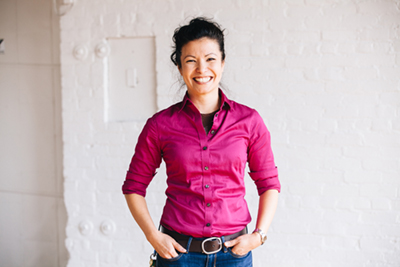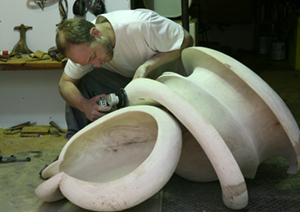Fall Exhibition Features Alumni Sculptures

This fall, the Ewing Gallery of Art + Architecture presents Irons in the Fire: UT Sculpture Alumni Exhibition in conjunction with the 2018 Mid-South Sculpture Alliance Conference, which is co-hosted by the UT Sculpture program. This three-day conference will bring hundreds of artists to Knoxville, including the renowned sculptor and printmaker Chakaia Booker, who will give a keynote address at the Knoxville Museum of Art and open her solo exhibition at the UT Downtown Gallery, both on Friday, Oct. 5.
The Irons in the Fire: UT Sculpture Alumni Exhibition is curated by UT alumnus Bill FitzGibbons (’72). FitzGibbons will give a juror’s talk during the closing reception at 4:30 p.m. Saturday, Oct. 6. The exhibition and reception are free and open to the public.
In celebration of the UT Sculpture program, we are featuring two notable alumni, Leticia R. Bajuyo (’01), MFA sculpture alumna, and Hunt Clark (’94).
Leticia R. Bajuyo is a sculptor and installation artist from Metropolis, Illinois, whose work examines the evolution of technology and the growth of the global market. Her work is included in the Irons in the Fire: UT Sculpture Alumni exhibition at UT, which runs Sept. 16–Oct. 7.
This year marks the 20th anniversary of Bajuyo’s beginning her MFA program at UT. In preparing for the alumni show, she’s been reflecting on how her graduate school experience shaped her trajectory as an artist.
“Looking back 20 years, I recognize that those three years at UT fostered a conceptual development, an exploration of media and space, a respect for fabrication and casting techniques, and an interest in interdisciplinary collaboration that I continue to rely upon in both my teaching and studio practice,” Bajuyo says.

“While at Tennessee, I had many mentors, for I was there during a significant turnover in the sculpture faculty. Ever a pragmatic optimist, I worked to connect with the retiring faculty, visiting faculty and new faculty as quickly as possible and welcomed the opportunities for a range of understandings and approaches to artistic exploration, experimentation, and execution.”
Bajuyo also appreciates the opportunity she had to study “beyond the walls of sculpture,” taking courses in art history, drawing, printmaking, ceramics, and museum studies. She expresses special gratitude to Tim Hiles, professor of art history, who served as the chair of her MFA thesis.
Bajuyo’s multidisciplinary approach continues as she currently works on a site-specific installation made from donated compact discs inside the Silos at Sawyer Yards—formerly a rice-processing facility in Houston, Texas, and creates studio pieces using materials such as artificial grass, cast bronze, and soap. Although the media varies, Bajuyo says her studio practice is fueled by a critique of consumer capitalism as it produces a “machine of desire that desires a machine.”
While a student at UT, Bajuyo took full advantage of scholarships, teaching, and gallery opportunities, twice receiving the Terry Burnett Memorial Award, teaching several sculpture courses, and co-directing Gallery 1010 with Mark Hosford (’01).
Her experiences in and out of the studio led to Bajuyo’s acceptance of a tenure-track professorship at Hanover College in 2001, the same year she graduated from UT. In 2016, she returned to Notre Dame as a visiting professor and is not an assistant professor of sculpture at Texas A&M Corpus Christi.
Bajuyo serves on the boards of the National Performance Network and the Mid-South Sculpture Alliance. She has exhibited her work nationally and internationally, including museum acquisitions of Amplitude, suspended in the three-story atrium of the South Bend Museum of Art in Indiana, and Shipshape, at the From Waste to Art Museum in Baku, Azerbaijan.


Hunt Clark is a multimedia artist from Sparta, Tennessee, who works primarily in painting, sculpture, and video-based installation. His installations use robotics to travel his projections through space and often include sound, resulting in multi-sensory, immersive environments. He’s developed an unconventional approach to carving that has resulted in extremely thin and technically difficult wood forms. In 2000, he began combining these wood forms with video projections. Clark manipulates the moving images by controlling and altering three-dimensional surfaces. He describes the process as similar to the activity of painting.
The Philadelphia Museum of Art recently acquired one of Clark’s sculptures, bmn508, for their permanent collection, and his work has been acquired by the Yale University Art Gallery, the Honolulu Museum of Art, the Museum of Fine Arts, Boston, and more. His video installation Traffic is on display at the Museum of Fine Arts, Houston, as part of the exhibition Digital Worlds: New Media from the Museum’s Collection through October 8, 2018. Clark’s video/sculptures have also been shown at the Whitespace collection in West Palm Beach, Florida, the 2013 Cheongju International Art Biennale in South Korea, and at the Museum of Art and Design in New York.

Clark began his studies at UT in 1989 as an architecture student and took a painting class as an elective. He realized that the study of art provided a more direct approach to investigating the concepts that interested him, and soon switched his course of study to painting and sculpture.
“I’ve always been non-prejudiced when it comes to combining disciplines,” Clark says. He stands by his interdisciplinary approach, though he often encounters opposition to his combinations. Clark credits his education at UT with offering a “very freeing” approach to art-making.
“It wasn’t until later in my career, after being a visiting artist and lecturer at other universities, that I realized how special the University of Tennessee’s art program is,” Clark says. The Artist-in-Residence program in particular influenced Clark’s development as an artist. “The visiting artists’ uninhibited approach to teaching was exciting, and gave me insight into what was going on in the art world at that time.”
“So many students who went through the program while I was at UT are making ground-breaking work,” says Clark, naming Marlo Pascual, Wade Guyton, Kelly Walker, Amy Green, Kevin Bradley, and Meredyth Sparks. “The professors instilled in us the seriousness and importance of art.”
